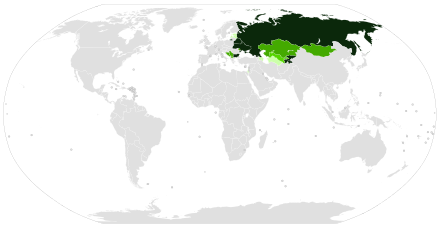
Numerous Cyrillic alphabets are based on the Cyrillic script. The early Cyrillic alphabet was developed in the 9th century AD and replaced the earlier Glagolitic script developed by the theologians Cyril and Methodius. It is the basis of alphabets used in various languages, past and present, Slavic origin, and non-Slavic languages influenced by Russian. As of 2011, around 252 million people in Eurasia use it as the official alphabet for their national languages. About half of them are in Russia. Cyrillic is one of the most-used writing systems in the world. The creator is Saint Clement of Ohrid from the Preslav literary school in the First Bulgarian Empire.
Some of these are illustrated below; for others, and for more detail, see the links. Sounds are transcribed in the IPA. While these languages largely have phonemic orthographies, there are occasional exceptions—for example, Russian ⟨г⟩ is pronounced /v/ in a number of words, an orthographic relic from when they were pronounced /ɡ/ (e.g. его yego 'him/his', is pronounced [jɪˈvo] rather than [jɪˈɡo]).
Spellings of names transliterated into the Roman alphabet may vary, especially й (y/j/i), but also г (gh/g/h) and ж (zh/j).
Unlike the Latin script, which is usually adapted to different languages by adding diacritical marks/supplementary glyphs (such as acutes and carons) to standard Roman letters, by assigning new phonetic values to existing letters (e.g. ⟨q⟩, whose original value in Latin was /k/, represents /g/ in Azerbaijani, /t͡ɕʰ/ in Mandarin Chinese Pinyin, /q/ in a lot of other languages and /ǃ/ in some Bantu languages), or by the use of digraphs (such as ⟨sh⟩), the Cyrillic script is usually adapted by the creation of entirely new letter shapes. However, in some alphabets invented in the 19th century, such as Chuvash, umlauts and breves also were used.
Bulgarian and Bosnian Sephardim without Hebrew typefaces occasionally printed Judeo-Spanish in Cyrillic.[1]
- ^ Šmid (2002), pp. 113–24: "Es interesante el hecho que en Bulgaria se imprimieron unas pocas publicaciones en alfabeto cirílico búlgaro y en Grecia en alfabeto griego... Nezirović (1992: 128) anota que también en Bosnia se ha encontrado un documento en que la lengua sefardí está escrita en alfabeto cirilico." Translation: "It is an interesting fact that in Bulgaria a few [Sephardic] publications are printed in the Bulgarian Cyrillic alphabet and in Greece in the Greek alphabet... Nezirović (1992:128) writes that in Bosnia a document has also been found in which the Sephardic language is written in the Cyrillic alphabet."